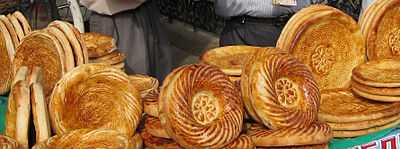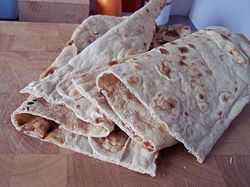Naan
| Naan | |
|---|---|
 | |
| Course | Snack, appetizer, bread |
| Place of origin | Persia (present day Iran) |
| Serving temperature | Hot, room temperature |
| Main ingredients | Wheat flour (e.g. atta, maida), water, yeast, cooking fat (e.g. butter, ghee), yogurt, milk (optional) |
|
| |
Naan, nan or khamiri is a leavened, oven-baked flatbread[1] found in the cuisines of West, Central and South Asia.[2][3][4] With the migration of the Roma people from India, it spread to other parts of West Asia.
Etymology
The earliest appearance of "nan" in English is from 1810, in a travelogue of William Tooke.[5] The Persian word nān 'bread' (Uzbek non/нон) is already attested in Middle-Persian/Pahlavi as n'n 'bread, food'. The form itself is of Iranian origin; cognate forms include Parthian ngn, Balochi nagan, Sogdian nγn-, Pashto nəγan 'bread'.[6]
The form naan has a widespread distribution, having been borrowed in a range of languages spoken in central and south Asia, where it usually refers to a kind of flatbread. The spelling naan is first attested in 1979,[7] and has since become the normal English spelling.
Description

The most familiar and readily available varieties of naan in Western countries are the South Asian varieties. In Iran, from which the word ultimately originated,[8] nān (نان) does not carry any special significance, as it is merely the generic word for any kind of bread. Naan in other parts of South Asia usually refers to a specific kind of thick flatbread (another well-known kind of flatbread is chapati). Generally, it resembles pita and, like pita bread, is usually leavened with yeast or with bread starter (leavened naan dough left over from a previous batch); unleavened dough (similar to that used for roti) is also used. Naan is cooked in a tandoor, from which tandoori cooking takes its name. This distinguishes it from roti, which is usually cooked on a flat or slightly concave iron griddle called a tava. Modern recipes sometimes substitute baking powder for the yeast. Milk or yogurt may also be used to impart distinct tastes to the naan. Milk used instead of water will, as it does for ordinary bread, yield a softer dough.[9] Also, when bread starter (which contains both yeast and lactobacilli) is used, the milk may undergo modest lactic fermentation.
Typically, it is served hot and brushed with ghee or butter. It can be used to scoop other foods, or served stuffed with a filling. For example, keema naan is stuffed with a minced meat mixture (usually lamb or mutton or goat meat); another variation is peshawari naan. Peshawari naan and Kashmiri naan are filled with a mixture of nuts and raisins; in Pakistan, roghani naan is sprinkled with sesame seeds; Kulcha is another type. Amritsari naan also called as amritsari kulcha is stuffed with mashed potatoes, onion (optional) and lots of spices. Possible seasonings in the naan dough include cumin and nigella seeds. The Pakistani dish of balti is usually eaten with a naan, and this has given rise to the huge karack or table naan, easy to share amongst large groups.[10]
A typical naan recipe involves mixing white flour with salt, a yeast culture, and enough yogurt to make a smooth, elastic dough.[11] The dough is kneaded for a few minutes, then set aside to rise for a few hours. Once risen, the dough is divided into balls (about 100 grams or 3.5 oz each), which are flattened and cooked. In Pakistani cuisine, naans are typically graced with fragrant essences, such as rose, khus (vetiver), or with butter or ghee melted on them. Nigella seeds are commonly added to naan as cooked in Indian restaurants throughout the UK.
Raisins and spices can be added to the bread to add to the flavour. Naan can also be covered with, or serve as a wrap for various toppings of meat, vegetables or cheeses. This version is sometimes prepared as fast food. It can also be dipped into such soups as dal, and goes well with sabzis (also known as shaakh).
Naan bya in Burma is sometimes served at breakfast with tea or coffee. It is round, soft, and blistered, often buttered, or with pè byouk (boiled peas) on top, or dipped in hseiksoup (mutton soup).
Naan pizza is a type of pizza where naan is used as the crust instead of the traditional pizza dough. Chefs and companies such as Nigella Lawson,[12] Whole Foods[13] and Wegmans[14] offer recipes for people to make their own naan pizza at home.
Gallery
-

Afghan naan
-
Barbari bread (Naan Barbari), an Iranian naan prepared in a stone tandoor
-

A selection of Tajik non at the market
-

Cheese naan
-
Naan bya with mutton soup, sometimes served at breakfast in Burma (also known as Myanmar)
See also
References
- ↑ Bernard Clayton's New Complete Book of Breads by Bernard Clayton, Donnie Cameron
- ↑ Qmin by Anil Ashokan, Greg Elms
- ↑ The Science of Cooking, Peter Barham, Springer: 2001. ISBN 978-3-540-67466-5. p. 118.
- ↑ The Bread Lover's Bread Machine Cookbook by Beth Hensperger
- ↑ Russia, or a Complete Historical Account of all the Nations which compose that Empire, London, p. 168: "The most common dishes are onoschi, or vermicelli; plav, or boiled rice; nan, pancakes, and the meats which the law permits." (referring to the eating habits of the central Turks). Other attestations in English can be found in the Oxford English Dictionary, s.v. naan.
- ↑ See for instance Manfred Mayrhofer, Etymologisches Wörterbuch des Altindoarischen, Heidelberg 1996, vol. 2, p. 6, with further references. An Indo-European origin for this typical cultural term is highly unlikely.
- ↑ Oxford English Dictionary
- ↑ Merriam-webster.com
- ↑ Harold McGee. On Food and Cooking. Scribner. 2nd Ed, 2004.
- ↑ Birmingham, the latest hot destination for foodies
- ↑ Recipe (video clip)
- ↑ http://www.nigella.com/recipes/view/naan-pizza-9
- ↑ http://www.wholefoodsmarket.com/recipe/grilled-veggie-naan-pizzas-goat-cheese
- ↑ http://www.wegmans.com/webapp/wcs/stores/servlet/RecipesView?Ntk=RecipeSearch&N=78&Nty=1&storeId=10052&langId=-1&catalogId=10002&Ntx=mode+MatchAllPartial&forwardto=RecipesView&Ntt=naan+pizza&quickRecipe_Ntt=naan+pizza
External links
| Wikimedia Commons has media related to Naan. |
| Wikibooks Cookbook has a recipe/module on |
| ||||||||||||||||||||||||||||||||||||||||||||||||||
| ||||||||||||||
| ||||||||||||||
| |||||||||||||||||||||||||
| ||||||||||||||||||||||||||||||||||||||||||







